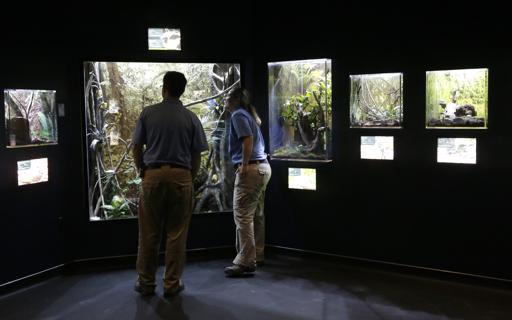Zoo employees at the Houston Zoo’s new bug house get their first look at the exhibits Friday, May 23, 2014, in Houston. The Bug House, opening this weekend, has 30 species of native and exotic insects on display.
“They’re fascinating and they’re just hard to see out in the wild,” Kevin Hodge, curator of the Children’s Zoo at the park, said Friday as workers were putting final touches on the $3 million project. “Most of these insects around here no one’s ever going to see on a trip to Africa or Malaysia. A lot of times they’re at the very tops of trees and could be among thousands of animals living on one huge canopy tree.”
A specialized insect display seems appropriate in Houston, a city that’s grown up on what was a swamp and where disease-carrying mosquitoes and 2-inch-long flying cockroaches are accepted facts of life.
The homegrown roaches, though, are dwarfed by the giant cave cockroaches from Panama and northern South America that are housed in one of the 25 aquarium-like exhibits.
Other impressive insects on display are black Asian forest scorpions from Malaysia, white-eyed assassin bugs from South Africa and blue death feigning beetles, which flop over on their blue backs and play dead when confronted with desert predators that prefer live victims.
The bug house also is home for a red-spotted longhorn beetle, which hails from Southeast Asia, and a Gooty sapphire tarantula, named for the town in southern India where it was discovered.
Insects and spiders — there are more than a million species of them — are vital as recyclers, aiding in decomposition and cleanup of organic matter. They also help in food production, silk production and are a food source for other animals. Pollinating insects are important for plant reproduction and crop production. Spiders, for example, are crucial for controlling pest insects that otherwise would devour food crops.
“They’re not just creepy crawly things we want to get rid of,” Hodge said. “Insects are a good indicator of how the planet is doing as a whole.”
The new 2,000-square-foot “Bug House” building is the result of about two years of work and eight months of construction. It required multiple U.S. Department of Agriculture inspections and permits covering the building itself, species, and native and exotic insects..
“We’re taking something that people rarely see and are bringing them into a place where they can appreciate nature,” Hodge said.
The 55-acre Houston Zoo is among the nation’s most visited zoos, last year attracting some 2.2 million visitors.
Agencies/AP/Canadajournal
 Canada Journal – News of the World Articles and videos to bring you the biggest Canadian news stories from across the country every day
Canada Journal – News of the World Articles and videos to bring you the biggest Canadian news stories from across the country every day



